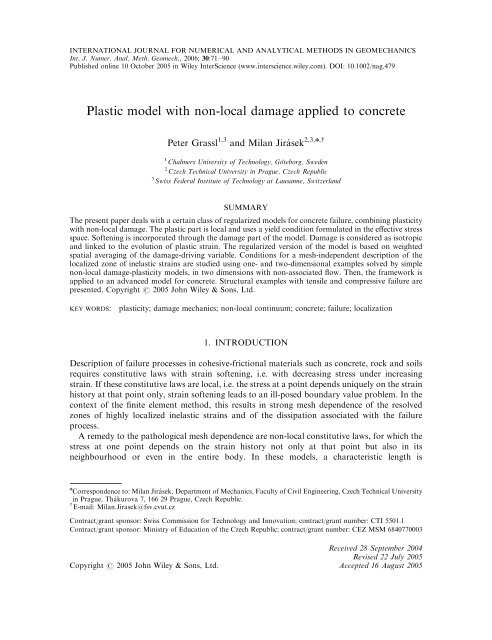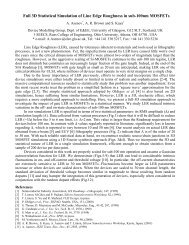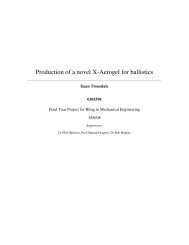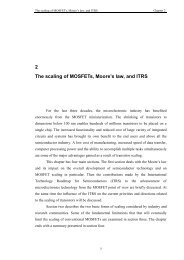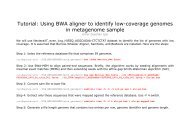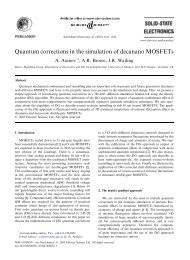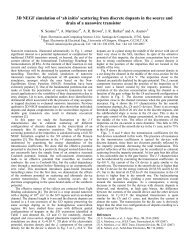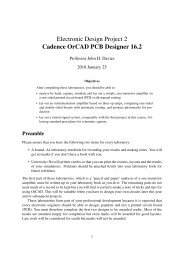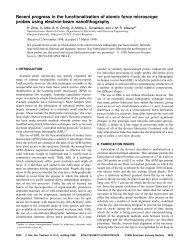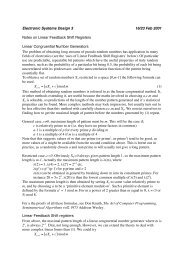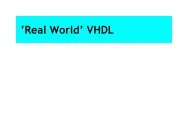Plastic model with non-local damage applied to concrete
Plastic model with non-local damage applied to concrete
Plastic model with non-local damage applied to concrete
Create successful ePaper yourself
Turn your PDF publications into a flip-book with our unique Google optimized e-Paper software.
INTERNATIONAL JOURNAL FOR NUMERICAL AND ANALYTICAL METHODS IN GEOMECHANICSInt. J. Numer. Anal. Meth. Geomech., 2006; 30:71–90Published online 10 Oc<strong>to</strong>ber 2005 in Wiley InterScience (www.interscience.wiley.com). DOI: 10.1002/nag.479<strong>Plastic</strong> <strong>model</strong> <strong>with</strong> <strong>non</strong>-<strong>local</strong> <strong>damage</strong> <strong>applied</strong> <strong>to</strong> <strong>concrete</strong>Peter Grassl 1,3 and Milan Jirásek 2,3,n,y1 Chalmers University of Technology, Go¨teborg, Sweden2 Czech Technical University in Prague, Czech Republic3 Swiss Federal Institute of Technology at Lausanne, SwitzerlandSUMMARYThe present paper deals <strong>with</strong> a certain class of regularized <strong>model</strong>s for <strong>concrete</strong> failure, combining plasticity<strong>with</strong> <strong>non</strong>-<strong>local</strong> <strong>damage</strong>. The plastic part is <strong>local</strong> and uses a yield condition formulated in the effective stressspace. Softening is incorporated through the <strong>damage</strong> part of the <strong>model</strong>. Damage is considered as isotropicand linked <strong>to</strong> the evolution of plastic strain. The regularized version of the <strong>model</strong> is based on weightedspatial averaging of the <strong>damage</strong>-driving variable. Conditions for a mesh-independent description of the<strong>local</strong>ized zone of inelastic strains are studied using one- and two-dimensional examples solved by simple<strong>non</strong>-<strong>local</strong> <strong>damage</strong>-plasticity <strong>model</strong>s, in two dimensions <strong>with</strong> <strong>non</strong>-associated flow. Then, the framework is<strong>applied</strong> <strong>to</strong> an advanced <strong>model</strong> for <strong>concrete</strong>. Structural examples <strong>with</strong> tensile and compressive failure arepresented. Copyright # 2005 John Wiley & Sons, Ltd.KEY WORDS:plasticity; <strong>damage</strong> mechanics; <strong>non</strong>-<strong>local</strong> continuum; <strong>concrete</strong>; failure; <strong>local</strong>ization1. INTRODUCTIONDescription of failure processes in cohesive-frictional materials such as <strong>concrete</strong>, rock and soilsrequires constitutive laws <strong>with</strong> strain softening, i.e. <strong>with</strong> decreasing stress under increasingstrain. If these constitutive laws are <strong>local</strong>, i.e. the stress at a point depends uniquely on the strainhis<strong>to</strong>ry at that point only, strain softening leads <strong>to</strong> an ill-posed boundary value problem. In thecontext of the finite element method, this results in strong mesh dependence of the resolvedzones of highly <strong>local</strong>ized inelastic strains and of the dissipation associated <strong>with</strong> the failureprocess.A remedy <strong>to</strong> the pathological mesh dependence are <strong>non</strong>-<strong>local</strong> constitutive laws, for which thestress at one point depends on the strain his<strong>to</strong>ry not only at that point but also in itsneighbourhood or even in the entire body. In these <strong>model</strong>s, a characteristic length isn Correspondence <strong>to</strong>: Milan Jirásek, Department of Mechanics, Faculty of Civil Engineering, Czech Technical Universityin Prague, Thákurova 7, 166 29 Prague, Czech Republic.y E-mail: Milan.Jirasek@fsv.cvut.czContract/grant sponsor: Swiss Commission for Technology and Innovation; contract/grant number: CTI 5501.1Contract/grant sponsor: Ministry of Education of the Czech Republic; contract/grant number: CEZ MSM 6840770003Copyright # 2005 John Wiley & Sons, Ltd.Received 28 September 2004Revised 22 July 2005Accepted 16 August 2005
72P. GRASSL AND M. JIRÁSEKincorporated, which allows mesh-independent description of energy dissipation in a <strong>local</strong>izedfailure process. Typically, the deformations remain continuous even in the <strong>local</strong>ized zone. Forintegral-type <strong>non</strong>-<strong>local</strong> <strong>model</strong>s, the interaction between neighbouring points is taken in<strong>to</strong>account by weighted spatial averaging. Such formulations were initially proposed in the contex<strong>to</strong>f elasticity [1] and hardening plasticity [2], and they were <strong>applied</strong> as <strong>local</strong>ization limiters for thefirst time by Pijaudier-Cabot and Bazˇ ant [3] in the context of <strong>damage</strong> mechanics. For softeningplasticity, integral-type <strong>non</strong>-<strong>local</strong> <strong>model</strong>s were developed, for instance, by Bazˇ ant and Lin [4],Vermeer and Brinkgreve [5], Leblond et al. [6], Tvergaard and Needleman [7], or Stro¨mberg andRistinmaa [8]. Thermodynamic aspects were discussed by Svedberg and Runesson [9] andBorino et al. [10], and numerical implementation issues by Benvenuti and Tralli [11] andRolshoven and Jira´sek [12]. For an overview and discussion of various <strong>non</strong>-<strong>local</strong> plasticityformats, see Reference [13].With plasticity or <strong>damage</strong> mechanics alone, the complex failure process of cohesive-frictionalmaterials, which is characterized by stiffness degradation and irreversible deformations, cannotbe <strong>model</strong>led satisfac<strong>to</strong>rily. <strong>Plastic</strong>ity is based on an elastic unloading stiffness, which is incontradiction <strong>to</strong> the stiffness degradation observed in experiments. Damage mechanics, on theother hand, is not suitable for the description of the irreversible deformations. A combination ofplasticity and <strong>damage</strong> mechanics can describe most of the important features of the failure ofcohesive-frictional materials. Combinations of stress-based plasticity and scalar <strong>damage</strong> weredeveloped, for example, by Ju [14], Lubliner et al. [15], Lee and Fenves [16], Gatuingt andPijaudier-Cabot [17], Bourgeois et al. [18], Kra¨tzig and Polling [19], Jason et al. [20, 21], Salariet al. [22], and Grassl and Jira´sek [23, 24]. Regularization of such <strong>model</strong>s by gradient <strong>damage</strong>formulations was proposed by de Borst et al. [25] and Addessi et al. [26].A special group of integral-type <strong>non</strong>-<strong>local</strong> <strong>damage</strong>-plastic <strong>model</strong>s, for which the <strong>damage</strong> partis driven by a <strong>non</strong>-<strong>local</strong> measure of the plastic strains, was studied analytically by Jira´sek andGrassl [27]. The present paper is a continuation of that work. The conclusions of the analyticalstudy of the <strong>non</strong>-<strong>local</strong> <strong>damage</strong>-plastic <strong>model</strong> are confirmed by one- and two-dimensionalexamples using simple versions of such <strong>model</strong>, in two dimensions <strong>with</strong> <strong>non</strong>-associated flow. Inparticular, the conditions for a mesh-independent description of the zone of inelastic strains arestudied. Then, the framework is <strong>applied</strong> <strong>to</strong> an advanced <strong>damage</strong>-plastic <strong>model</strong> for <strong>concrete</strong>,recently developed by the present authors [23, 24]. With this <strong>non</strong>-<strong>local</strong> <strong>damage</strong>-plastic <strong>model</strong>,structural examples of tensile and compressive failure are computed.2. BASIC EQUATIONS OF COMBINED PLASTICITY AND DAMAGEIn the present section, the framework for the combination of stress-based plasticity and strainbasedscalar <strong>damage</strong> is first presented in the <strong>local</strong> setting. The general stress–strain relation forthis class of <strong>model</strong>s isr ¼ð1 oÞD e : ðe e p Þ¼ð1 oÞ%r ð1Þwhere r is the stress, o is the <strong>damage</strong> variable, D e is the isotropic elastic stiffness, e is the strain,e p is the plastic strain, and %r ¼ D e : ðe e p Þ is the effective stress. For o ¼ 0; Equation (1)reduces <strong>to</strong> the stress–strain relation of an elastic–plastic <strong>model</strong>, and for e p ¼ 0 <strong>to</strong> an elastic<strong>damage</strong><strong>model</strong>. Of course, the stress–strain equation (1) must be supplemented by certain lawsspecifying the evolution of plastic strain and <strong>damage</strong>. In paper [24], the present authors compareCopyright # 2005 John Wiley & Sons, Ltd. Int. J. Numer. Anal. Meth. Geomech. 2006; 30:71–90
PLASTIC MODEL WITH NON-LOCAL DAMAGE 73several options and propose an approach using a yield condition postulated in the effectivestress space and a <strong>damage</strong> law driven by the plastic strain.The plastic part of the <strong>model</strong> is based on the standard flow theory of plasticity, <strong>with</strong> all thebasic equations written in terms of the effective stress:’e p ¼ l ’ @g pð%r; k p Þð2Þ@%r’k p ¼ ’lk p ð%r; k p Þ ð3Þs y ¼ hðk p Þð4Þf p ð%r; s y Þ40; l50; ’ lfp ’ ð%r; s y Þ¼0 ð5ÞHere, a superimposed dot denotes the time derivative, l is the plastic multiplier, k p is theplastic hardening variable, g p is the plastic potential, k p is a scaling fac<strong>to</strong>r that relates the rateof the plastic multiplier <strong>to</strong> the rate of the hardening variable (this fac<strong>to</strong>r is often constantbut, in general, can depend on the current values of stress and hardening variable), s y isthe current yield stress, h is the hardening function, and f p is the yield function. No softeningis considered in the plastic <strong>model</strong> itself, i.e. the hardening function h is <strong>non</strong>-decreasing.Softening effects are attributed <strong>to</strong> cracking and taken in<strong>to</strong> account by the <strong>damage</strong> part of the<strong>model</strong>.The <strong>damage</strong> evolution is driven by a certain internal variable k d ; which typically remains zeroduring the initial stage of plastic hardening and starts growing when the yielding process attainsa critical level. The corresponding value of k p is denoted as k 0 : The subsequent evolution of k d isclosely linked <strong>to</strong> the plastic strain rate. For simple versions of the <strong>model</strong>, we set ’k d ¼ ’k p ; so thatk d can be identified <strong>with</strong> the difference k p k 0 : For the <strong>model</strong> that aims at realistic descriptionof <strong>concrete</strong> (<strong>to</strong> be presented in Section 6), ’k d is related <strong>to</strong> the plastic strain rate through a morecomplicated expression; see Equation (19). The <strong>damage</strong> variable o is a function of the internalvariable k d ; i.e.o ¼ g d ðk d Þð6Þwhere the <strong>damage</strong> function g d mono<strong>to</strong>nically grows from zero <strong>to</strong> one.The algorithm for the stress update of this type of <strong>model</strong>s is divided in<strong>to</strong> two stages. First,the update of the effective stress for the plastic part is carried out by an implicit algorithm; then,the <strong>damage</strong> part is evaluated explicitly from the plastic strain increment obtained in thefirst stage.3. REGULARIZATION BY NON-LOCAL DAMAGEThe pathological mesh sensitivity of results obtained <strong>with</strong> <strong>local</strong> constitutive laws thatincorporate strain softening can be overcome by a suitable regularization technique, whichenforces mesh-independent dissipation associated <strong>with</strong> the failure process. Integral-type <strong>non</strong><strong>local</strong><strong>model</strong>s achieve this by weighted spatial averaging of a suitable state variable. Damage<strong>model</strong>s of this kind were first proposed by Pijaudier-Cabot and Bazˇ ant [3, 28], but many otherformulations appeared in the literature; see Reference [29] for a systematic comparison. OneCopyright # 2005 John Wiley & Sons, Ltd. Int. J. Numer. Anal. Meth. Geomech. 2006; 30:71–90
74P. GRASSL AND M. JIRÁSEKefficient <strong>non</strong>-<strong>local</strong> <strong>damage</strong> formulation replaces k d in (6) by its <strong>non</strong>-<strong>local</strong> counterpartZ%k d ðxÞ ¼ aðx; sÞk d ðsÞ dsVHere, V is the spatial domain occupied by the body of interest, and aðx; sÞ is a <strong>non</strong>-<strong>local</strong> weightfunction that describes the strength of interaction between points x and s and decays <strong>with</strong>increasing distance between these points. The weight function is usually <strong>non</strong>-negative andnormalized such that R Vaðx; sÞ ds ¼ 1 for all x 2 V: This can be achieved by settingaðx; sÞ ¼ a 0ðkx skÞRV a ð8Þ0ðkx tkÞ dtwhere a 0 ðrÞ is a function of the distance r ¼kx sk between points x and s: In the present studywe use the truncated polynomial function8r 2 2>< 1a 0 ðrÞ ¼ R 2 if r5Rð9Þ>:0 if r5RParameter R; called the radius of <strong>non</strong>-<strong>local</strong> interaction, sets the length scale of the <strong>model</strong> anddirectly affects the size of the <strong>local</strong>ized inelastic zone.A simple <strong>non</strong>-<strong>local</strong> version of plasticity would be obtained by replacing k p in (4) by %k p ; i.e. bythe <strong>non</strong>-<strong>local</strong> plastic hardening variable computed from k p using an averaging opera<strong>to</strong>r similar<strong>to</strong> (7). For this type of <strong>non</strong>-<strong>local</strong> plasticity <strong>model</strong>s, the plastic strain <strong>local</strong>izes in<strong>to</strong> a set of zeromeasure, but the energy dissipation does not vanish, as shown by Planas et al. [30] in the onedimensionalsetting. Full regularization <strong>with</strong> a <strong>non</strong>-vanishing width of the plastic zone isobtained if the softening process is driven by a linear combination of the <strong>local</strong> and <strong>non</strong>-<strong>local</strong>plastic hardening variables, as proposed by Vermeer and Brinkgreve [5]. This type of <strong>non</strong>-<strong>local</strong>formulation is computationally quite expensive, because the plastic stress-return algorithmcannot be performed for each Gauss integration point of the finite element <strong>model</strong> separately andglobal iteration during stress evaluation is needed [8,11,12].In the present study, the <strong>non</strong>-<strong>local</strong> <strong>damage</strong>-plastic <strong>model</strong> is composed of a <strong>local</strong> plastic partand a <strong>non</strong>-<strong>local</strong> <strong>damage</strong> part. In analogy <strong>to</strong> the Vermeer–Brinkgreve [5] idea, we replace the<strong>local</strong> variable k d in (6) by#k d ¼ m%k d þð1 mÞk d ð10Þwhich is a linear combination of the <strong>local</strong> value k d and <strong>non</strong>-<strong>local</strong> value %k d : The role of theadditional <strong>model</strong> parameter m will be discussed later. For m ¼ 1; the combined variable #k dcoincides <strong>with</strong> the <strong>non</strong>-<strong>local</strong> variable %k d defined in (7), whereas for m ¼ 0 it reduces <strong>to</strong> the <strong>local</strong>variable k d : In certain applications, values m > 1 are used, and this is why the formulation issometimes called ‘over-<strong>non</strong>-<strong>local</strong>’ [31].The present type of plastic <strong>model</strong> <strong>with</strong> <strong>non</strong>-<strong>local</strong> <strong>damage</strong> is computationally more efficientthan standard integral-type <strong>non</strong>-<strong>local</strong> plasticity <strong>model</strong>s, since the plastic part, which is implicitand requires iteration, remains <strong>local</strong>, and <strong>non</strong>-<strong>local</strong> averaging affects only the explicit<strong>damage</strong> part.The <strong>local</strong>ization behaviour of plastic <strong>model</strong>s <strong>with</strong> <strong>non</strong>-<strong>local</strong> <strong>damage</strong> has been studiedanalytically by the present authors. In the following, the main results from Reference [27]are summarized. The <strong>local</strong>ization behaviour is governed by the value of the plasticð7ÞCopyright # 2005 John Wiley & Sons, Ltd. Int. J. Numer. Anal. Meth. Geomech. 2006; 30:71–90
PLASTIC MODEL WITH NON-LOCAL DAMAGE 75hardening modulus:H p ¼@f p dh@s y dk pð11ÞMore specifically, the actual value of H is compared <strong>to</strong> two critical values, H crit and H crit;p ;which are obtained by classical <strong>local</strong>ization analysis of the corresponding <strong>local</strong> <strong>model</strong> based onthe acoustic tensor [32,33]. The value H crit is evaluated for the complete <strong>damage</strong>-plastic <strong>model</strong>,while H crit;p is evaluated for the plastic part only (<strong>with</strong> artificially ‘frozen’ <strong>damage</strong>). Thedifference between H crit and H crit;p ; denoted as DH crit;d ; is usually larger than zero. Anotherimportant characteristic value H dis is defined asH dis ¼ H crit;p þð1 mÞDH crit;d ð12ÞSuppose that the body deforms uniformly up <strong>to</strong> the current state, and the boundaryconditions admit a uniform solution of the rate problem. The question is whether this solution isunique, or whether there exists another solution <strong>with</strong> plastic yielding <strong>local</strong>ized in<strong>to</strong> a band.According <strong>to</strong> Jira´sek and Grassl [27], the following cases can be distinguished:* H crit 5H p }no <strong>local</strong>ization possible;* H dis 5H p 4H crit }<strong>local</strong>ization <strong>with</strong> continuous strain rate;* H p 5H dis }<strong>local</strong>ization <strong>with</strong> discontinuous strain rate.The special case H p ¼ H dis requires a more refined discussion.In the finite element method, a discontinuous strain rate usually corresponds <strong>to</strong> a fully<strong>local</strong>ized zone of plastic strains, which is related <strong>to</strong> the size of the finite element mesh. Incontrast <strong>to</strong> that, <strong>local</strong>ization <strong>with</strong> a continuous strain rate leads <strong>to</strong> a mesh-independent zone ofinelastic strains. In the following sections, specific versions of the <strong>non</strong>-<strong>local</strong> <strong>damage</strong>-plastic<strong>model</strong> for cohesive-frictional materials are <strong>applied</strong> <strong>to</strong> structural problems <strong>with</strong> different failuremodes. In particular, the influence of parameters m and H crit;p is studied.4. ONE-DIMENSIONAL PLASTICITY COMBINED WITH NON-LOCAL DAMAGEThe first structural example is a bar subjected <strong>to</strong> uniaxial tension (Figure 1). In this simple case,we set ’k p ¼j’e p j: The plastic part of the <strong>model</strong> exhibits hardening until the cumulative plasticstrain k p attains a certain level k 0 ; after which the behaviour becomes perfectly plastic(i.e. H p ¼ 0). The hardening law (4) has the <strong>non</strong>-linear form(s y ¼ hðk p Þ¼ s i þðs 0 s i Þðk 2 p 3k p k 0 þ 3k 2 0 Þk p=k 3 0if k p 4k 0ð13Þs 0 if k p > k 0where s i is initial yield stress, s 0 is the ultimate (maximum) yield stress, k p is the cumulativeplastic strain, and k 0 is the plastic strain at peak. The <strong>damage</strong> evolution starts when themaximum yield stress is mobilized (which happens at k p ¼ k 0 ) and is driven by the variableCopyright # 2005 John Wiley & Sons, Ltd. Int. J. Numer. Anal. Meth. Geomech. 2006; 30:71–90
76P. GRASSL AND M. JIRÁSEKweakened sectionxuL/2L/2FFigure 1. Geometry and loading set-up of the one-dimensional bar under uniaxial tension.k d ¼ k p k 0 according <strong>to</strong> the exponential <strong>damage</strong> law(o ¼ g d ðk d Þ¼ 0 if k d40ð14Þ1 expð k d =e f Þ if k d 50Parameter e f controls the slope of the softening curve.During <strong>damage</strong> evolution, the plastic hardening modulus H p is equal <strong>to</strong> zero, which in thepresent one-dimensional case corresponds <strong>to</strong> the critical value H crit;p ¼ 0: The <strong>model</strong> responsesfor m ¼ 1 and 2 are presented in Figure 2 in terms of the load–displacement curves and evolvingprofiles of plastic strain and <strong>damage</strong>. For m ¼ 1; the plastic strain is fully <strong>local</strong>ized, and <strong>damage</strong>is distributed in an interval of width 2R around the plastic zone (Figure 2, left). For m ¼ 2; theplastic strain is distributed continuously, and <strong>damage</strong> is uniform in the plastic zone anddecreases continuously <strong>to</strong> zero in intervals of width R on both sides of the plastic zone (Figure 2,right). In both cases, the load–displacement diagrams converge upon mesh refinement and thearea under them (dissipated energy) remains <strong>non</strong>-zero. For comparison, the dashed curves in theload–displacement diagrams show the unstable uniform solution.In the one-dimensional setting, H crit;p is equal <strong>to</strong> zero, so that the use of m ¼ 1 for the case ofperfect plasticity (H p ¼ 0) always leads <strong>to</strong> fully <strong>local</strong>ized plastic strains. However, in a multidimensionalcase <strong>with</strong> <strong>non</strong>-associated flow, the critical hardening modulus depends on the stressstate and can be larger or smaller than zero. This will be demonstrated in the next section.5. NON-ASSOCIATED DRUCKER-PRAGER PLASTICITY COMBINED WITHNON-LOCAL SCALAR DAMAGEThe second structural example deals <strong>with</strong> two-dimensional analysis of a rectangular panelsubjected <strong>to</strong> compression under plane-strain conditions. The geometry, the loading set-up andthree finite element discretizations are shown in Figure 3. The plastic part of the <strong>model</strong> uses theDrucker-Prager yield condition <strong>with</strong> a <strong>non</strong>-associated flow rule. The yield function is defined aspf p ð%r; s y Þ¼c f I 1 ð%rÞþffiffiffiffiffiffiffiffiffiffiJ 2 ð%rÞ s yð15Þwhere I 1 ¼ d : %r is the first invariant (trace) of the effective stress tensor, d is the unit secondordertensor (Kronecker delta), J 2 ¼ 1 2%s : %s is the second invariant of the devia<strong>to</strong>ric effectivestress tensor %s ¼ %r dI 1 =3; and c f is the friction coefficient. The <strong>non</strong>-associated flow rule isderived from the plastic potentialpg p ð%rÞ ¼c c I 1 ð%rÞþffiffiffiffiffiffiffiffiffiffiJ 2 ð%rÞð16ÞCopyright # 2005 John Wiley & Sons, Ltd. Int. J. Numer. Anal. Meth. Geomech. 2006; 30:71–90
PLASTIC MODEL WITH NON-LOCAL DAMAGE 77Hp = 0 and m = 1 Hp = 0 and m = 2normalized load10.80.60.40.2normalized load10.80.60.40.200 1 2 3 4normalized displacement00 1 2 3 4normalized displacementnormalized plastic strain200150100500-2 -1 0 1 2normalized coordinate x/Rnormalized plastic strain14121086420-2 -1 0 1 2normalized coordinate x/R11<strong>damage</strong>0.5<strong>damage</strong>0.50-2 -1 0 1 2normalized coordinate x/R0-2 -1 0 1 2normalized coordinate x/RFigure 2. Load–displacement diagram and evolution of plastic strain and <strong>damage</strong> in a bar under uniaxialtension for the <strong>non</strong>-<strong>local</strong> <strong>damage</strong>-plastic <strong>model</strong> <strong>with</strong> H p ¼ 0 and different values of m:Figure 3. Geometry, loading set-up and finite element discretizations of therectangular panel under plane strain.Copyright # 2005 John Wiley & Sons, Ltd. Int. J. Numer. Anal. Meth. Geomech. 2006; 30:71–90
78P. GRASSL AND M. JIRÁSEKwhere c c is the dilation coefficient. The plastic hardening variable is defined by the rate equationrffiffirffiffiffi2 2’k p ¼ jj’e p jj ¼ ’l @g p3 3 @%r ¼ l ’ qffiffiffiffiffiffiffiffiffiffiffiffiffiffiffiffiffiffiffiffi1=3 þ 2c 2 cð17Þwhich means that the scaling fac<strong>to</strong>r from (3) is for this particular <strong>model</strong> constant,qffiffiffiffiffiffiffiffiffiffiffiffiffiffiffiffiffiffiffiffik p ¼ 1=3 þ 2c 2 c: Damage is assumed <strong>to</strong> start growing right at the onset of yielding, and sothe variable k d is identical <strong>with</strong> k p : The <strong>damage</strong> law has again the exponential form (14).In the first example, the plastic part of the <strong>model</strong> is designed <strong>to</strong> be perfectly plastic <strong>with</strong> aconstant yield stress in shear s y ¼ s 0 : The parameters are Young’s modulus E ¼ 30 GPa;Poisson’s ratio n ¼ 0:2; s 0 ¼ 20 MPa; c f ¼ 0:1; c c ¼ 0:05; e f ¼ 0:0057 and R ¼ 100 mm:The load–displacement curves for the three meshes from Figure 3 are almost the same; seeFigure 4. The evolution of the increment of the cumulative plastic strain k p is shown in Figure 5.The plastic zone initially has a certain width and later is reduced <strong>to</strong> a single element layer. Thisbehaviour is explained by the evolution of the critical plastic hardening modulus H crit;p : Theexpression for H crit;p has been derived analytically by Runesson et al. [33] and can be written forthe present case according <strong>to</strong> Rolshoven [34] as2! 3 2EH crit;p ¼ 44k p ð1 nÞ 2ðc Sf c c Þ 2 3ð1 nÞ pffiffiffiffiþ c f þ c c5 ð18ÞJ 2where S 3 is the out-of-plane principal effective devia<strong>to</strong>ric stress. In Figure 6, the evolution ofH crit;p is compared <strong>to</strong> the hardening modulus for the loading path that corresponds <strong>to</strong> theconditions of Figure 3. At early stages of the loading process, H crit;p is below H p ¼ 0; and so theplastic zone remains distributed. During plastic flow the out-of-plane effective stress componentincreases, which results in an increase of H crit;p : Eventually, H crit;p becomes positive, which leads<strong>to</strong> a fully <strong>local</strong>ized plastic zone. The evaluation of the critical plastic hardening modulus in (18)is based on the analysis of a bifurcation from a uniform state. Nevertheless, this idealized2.52mediumfinevery finenormalized load1.510.500 0.001 0.002 0.003normalized <strong>to</strong>p displacementFigure 4. Load–displacement diagram for a panel loaded in compression under plane strain obtained <strong>with</strong>the <strong>non</strong>-<strong>local</strong> <strong>damage</strong>-plastic <strong>model</strong> <strong>with</strong> H p ¼ 0; m ¼ 1 and R ¼ 0:1 m on three different meshes.Copyright # 2005 John Wiley & Sons, Ltd. Int. J. Numer. Anal. Meth. Geomech. 2006; 30:71–90
PLASTIC MODEL WITH NON-LOCAL DAMAGE 79Figure 5. Increments of the plastic hardening variable at four stages of analysis (marked in Figure 4 byhollow circles) on the fine mesh; <strong>non</strong>-<strong>local</strong> <strong>damage</strong>-plastic <strong>model</strong> <strong>with</strong> H p ¼ 0; m ¼ 1 and R ¼ 0:1 m:0.01hardening moduli0-0.01-0.02-0.03Hcrit,pHp = 0Hp = 0.01-0.040 0.01 0.02 0.03plastic hardening variableFigure 6. Evolution of the critical hardening modulus of the plasticity <strong>model</strong> during yielding.analysis gives also some indication of the trend <strong>to</strong> be expected during the actual evolution of theplastic zone under <strong>non</strong>-uniform strain.There are two ways of preventing the formation of a fully <strong>local</strong>ized, and therefore meshdependent, zone of plastic strains. Firstly, the parameter m in (10) can be increased, similar <strong>to</strong>what was done in the one-dimensional examples in the preceding section. However, this helpsonly if the plastic modulus is exactly equal <strong>to</strong> the critical value, and not strictly smaller.Secondly, the plastic hardening modulus can be increased, so that it remains above the criticalvalue throughout the loading process, as shown in Figure 6 for H p ¼ 0:01:For the case of linear hardening <strong>with</strong> constant plastic modulus H p ¼ 0:01 and <strong>non</strong>-<strong>local</strong>formulation <strong>with</strong> m ¼ 1; the evolution of the increment of plastic hardening variable in asimulation on the fine mesh is depicted in Figure 7. The control parameter of the <strong>damage</strong> lawwas set <strong>to</strong> e f ¼ 0:0051; in order <strong>to</strong> obtain the same slope of the softening curve as in theCopyright # 2005 John Wiley & Sons, Ltd. Int. J. Numer. Anal. Meth. Geomech. 2006; 30:71–90
80P. GRASSL AND M. JIRÁSEKFigure 7. Increments of the plastic hardening variable at four stages of analysis on the fine mesh for the<strong>non</strong>-<strong>local</strong> <strong>damage</strong>-plastic <strong>model</strong> <strong>with</strong> H p ¼ 0:01; m ¼ 1 and R ¼ 0:1 m:preceding example. The plastic zone decreases but does not fully <strong>local</strong>ize. Instead, it converges<strong>to</strong> a constant width, larger than the element size. This response is in agreement <strong>with</strong> the resultsshown in Figure 6, where the difference between the critical plastic hardening modulus and theactual plastic hardening modulus decreases and then remains constant. Thus, for analysis <strong>with</strong>m ¼ 1 the final size of the <strong>local</strong>ized plastic zone is controlled by the interaction radius R and bythe difference H p H crit;p :6. CONCRETE PLASTICITY COMBINED WITH NON-LOCAL SCALAR DAMAGEIn the last two examples we use a triaxial plasticity <strong>model</strong> <strong>with</strong> <strong>non</strong>-<strong>local</strong> scalar <strong>damage</strong> insimulations of tensile and compressive failure of <strong>concrete</strong>. This regularized formulation is a <strong>non</strong><strong>local</strong>extension of the <strong>damage</strong>-plastic <strong>model</strong> developed by the authors [24], which is brieflyreviewed in the following.The plastic part of the <strong>model</strong> consists of a three-invariant yield condition, <strong>non</strong>-associated flowrule and pressure-dependent hardening. The yield surface, depicted in Figures 8 and 9, is basedon the Menétrey–Willam failure criterion [35], which depends on all three stress invariants(volumetric effective stress %s V ; norm of devia<strong>to</strong>ric effective stress %r and Lode angle y). Themeridians are parabolic and the devia<strong>to</strong>ric sections change from almost triangular shapes at lowconfinement <strong>to</strong> circular shapes at high confinement. The yield surface limits the stress inhydrostatic compression during hardening, which allows <strong>model</strong>ling of compaction under highlyconfined compression. The initial and intermediate yield surfaces have two vertices on thehydrostatic axis but the ultimate yield surface has only one vertex on the tensile part of thehydrostatic axis.The flow rule is <strong>non</strong>-associated, which is important for realistic <strong>model</strong>ling of the volumetricexpansion under low-confined compression. An associated flow rule for this type of yield surfacegives an unrealistically high volumetric expansion in compression. In the case of passiveconfinement, overestimation of the lateral expansion leads <strong>to</strong> an overestimated strength (peakstress), as shown by Grassl [36].Copyright # 2005 John Wiley & Sons, Ltd. Int. J. Numer. Anal. Meth. Geomech. 2006; 30:71–90
PLASTIC MODEL WITH NON-LOCAL DAMAGE 81432θ = 01ρ / fc0-1-2-3θ = π-4-4 -3 -2 -1 0σ V /f cFigure 8.Evolution of the meridional section of the yield surface during hardening.θ = 0θ = 4π / 3θ = 2π / 3Figure 9.Evolution of the devia<strong>to</strong>ric section of the yield surface during hardening for a constantvolumetric effective stress of %s V ¼ f c =3:The hardening law (13) is the same as for the one-dimensional example, <strong>with</strong> an initialincrease of the yield stress and perfectly plastic behaviour (no softening) after the ultimate yieldstress s 0 has been attained. The rate of plastic hardening variable is equal <strong>to</strong> the norm of theplastic strain rate scaled by a ductility measure based on the volumetric effective stress, whichaccounts for different hardening responses under tensile and compressive stress states.The <strong>damage</strong> growth is activated when the ultimate yield stress is mobilized, i.e. when k p ¼ k 0 :The <strong>damage</strong> law has again the exponential form (14). The rate of the <strong>damage</strong>-driving variable k dis proportional <strong>to</strong> the rate of volumetric plastic strain, ’e pV ; and is scaled by a ductilitymeasure x s that accounts for different amounts of dissipation associated <strong>with</strong> tensile andcompressive failures:’k d ¼ ’e pVx s ðR s ð%rÞÞð19ÞCopyright # 2005 John Wiley & Sons, Ltd. Int. J. Numer. Anal. Meth. Geomech. 2006; 30:71–90
82P. GRASSL AND M. JIRÁSEKwhere(x s ðR s Þ¼ 1 þ A sR 2 s if R s 51pffiffiffiffiffið20Þ1 3A s þ 4A s R s if R s 51A s is a <strong>model</strong> parameter determined from the softening response in uniaxial compression. Thedimensionless variable R s ¼ ’e pV =’e pV is defined as the ratio between the ‘negative’ volumetricplastic strain rate’e pV ¼ X3I¼1h ’e pI i ð21Þand the volumetric plastic strain rate ’e pV ¼ d : _e p : Since this ratio depends only on the flowdirection @g p =@%r; R s can be considered as a function of the effective stress. In (21), ’e pI are theprincipal components of the rate of plastic strains and hi denotes the McAuley brackets(positive-part opera<strong>to</strong>r). For uniaxial tension, for instance, all three principal plastic strain ratesare <strong>non</strong>-negative, and so ’e pV ¼ 0; R s ¼ 0 and x s ¼ 1: This means that under uniaxial tensileloading we have k d ¼ k p k 0 ; same as for the simple one-dimensional <strong>model</strong> from Section 4. Onthe other hand, under compressive stress states the negative principal plastic strain rates lead <strong>to</strong>a ductility measure x s larger than one and the evolution of <strong>damage</strong> is slowed down. It should beemphasized that the flow rule for this specific <strong>model</strong> is constructed such that the volumetric par<strong>to</strong>f plastic strain rate at the ultimate yield surface cannot be negative.The <strong>damage</strong>-plastic <strong>model</strong> contains 15 parameters, but only 6 of them are actually calibratedfor different <strong>concrete</strong> types, namely Young’s modulus E; Poisson’s ratio n; tensile strength f t ;compressive strength f c ; parameter e f of the <strong>damage</strong> law (14), and parameter A s in the ductilitymeasure (20) of the <strong>damage</strong> <strong>model</strong>. The remaining parameters are set <strong>to</strong> their default valuesspecified in Reference [24].The response of the <strong>local</strong> <strong>model</strong> has been compared <strong>to</strong> several material tests in Reference [24].It has been shown that the <strong>model</strong> can describe the failure of <strong>concrete</strong> under tension and uniaxial,biaxial and triaxial compression. Here, only two selected examples are reproduced: uniaxialtension <strong>with</strong> unloading tested by Gopalaratnam and Shah [37] (Figure 10) and uniaxialcompression <strong>with</strong> unloading tested by Karsan and Jirsa [38] (Figure 11).The <strong>non</strong>-<strong>local</strong> extension of the <strong>model</strong> is straightforward. The <strong>local</strong> variable k d is in the<strong>damage</strong> law (14) replaced by the ‘over-<strong>non</strong>-<strong>local</strong>’ variable #k d defined in (10). Note that,for m > 1; #k d can be negative, and so it is important <strong>to</strong> include in (14) the definition of g d fornegative arguments.6.1. Three-point bending testThe first structural example <strong>with</strong> the <strong>non</strong>-<strong>local</strong> <strong>damage</strong>-plastic <strong>model</strong> for <strong>concrete</strong> is a threepointbending test of a single-edge notched beam reported by Kormeling and Reinhardt [39]; seeFigure 12.The experiment is <strong>model</strong>led by triangular plane-strain finite elements. For this type ofanalysis, <strong>local</strong> stress–strain relations <strong>with</strong> strain softening are known <strong>to</strong> result in meshdependentload–displacement curves. The capability of the <strong>non</strong>-<strong>local</strong> <strong>damage</strong>-plastic <strong>model</strong> <strong>to</strong>overcome this pathological dependence is assessed by three analyses on three meshes <strong>with</strong>element sizes of 7.5, 5 and 2:5 mm; see Figure 12 for the coarse mesh.Copyright # 2005 John Wiley & Sons, Ltd. Int. J. Numer. Anal. Meth. Geomech. 2006; 30:71–90
PLASTIC MODEL WITH NON-LOCAL DAMAGE 834constitutive responseexperimentsstress [MPa]32100 0.2 0.4strain [mm/m]Figure 10. Model response under uniaxial tension <strong>with</strong> unloading compared <strong>to</strong> experimental resultsreported by Gopalaratnam and Shah [37].0-10stress [MPa]-20-30constitutive responseexperiments-4 -3 -2 -1 0strain [mm/m]Figure 11. Model response under uniaxial compression <strong>with</strong> unloading compared <strong>to</strong> experimental resultsreported by Karsan and Jirsa [38].The material parameters are E ¼ 20 GPa; n ¼ 0:2; f t ¼ 2:4 MPa; f c ¼ 24 MPa; e f ¼ 0:001025and A s ¼ 2: The other parameters of the <strong>local</strong> <strong>damage</strong>-plastic <strong>model</strong> are set <strong>to</strong> their defaultvalues [24]. The <strong>non</strong>-<strong>local</strong> parameters are taken as R ¼ 25 mm and m ¼ 1:The load–displacement curve obtained on the fine mesh is in a reasonable agreement <strong>with</strong> theexperiment, cf. Figure 13, and the results do not suffer by pathological sensitivity <strong>to</strong> the meshsize, cf. Figure 14. The con<strong>to</strong>ur plots of the <strong>damage</strong> variable and the increment of the volumetricplastic strain at three stages of the analysis (marked by hollow circles in Figure 14) on the finemesh are presented in Figure 15. The plastic strain tends <strong>to</strong> fully <strong>local</strong>ize and the <strong>damage</strong> isdistributed over distance R around the plastic zone.Copyright # 2005 John Wiley & Sons, Ltd. Int. J. Numer. Anal. Meth. Geomech. 2006; 30:71–90
84P. GRASSL AND M. JIRÁSEKFigure 12. Geometry, loading set-up and finite element mesh for the three-point bending test.1.61.4fine meshexp bounds1.2load [kN]10.80.60.40.200 0.2 0.4 0.6 0.8 1displacement [mm]Figure 13. Comparison of the analysis of the three-point bending test on the fine mesh<strong>with</strong> the experimental bounds.A continuous plastic strain profile can be obtained by increasing either H p or m: Nevertheless,even the <strong>non</strong>-<strong>local</strong> <strong>model</strong> <strong>with</strong> <strong>local</strong>izing plastic strains is still advantageous over <strong>local</strong> <strong>model</strong>sbased on the crack band concept [40], which are widely used in commercial finite element codes.For <strong>model</strong>s based on the crack band concept, the global load–displacement curves are mademesh-independent by adjustment of the <strong>local</strong> softening curve <strong>with</strong> respect <strong>to</strong> the size of the zonein which plastic strain <strong>local</strong>izes. Under tensile loading, the size of this zone is dictated by theelement size. Under compressive loading, however, the size of the <strong>local</strong>ized zone may beindependent of the element size. If the structural failure involves both <strong>local</strong> tensile andcompressive mechanisms, single-surface <strong>model</strong>s like the present one based on the crack bandapproach would fail <strong>to</strong> describe the energy dissipation independently of the mesh. Such anexample is analysed by the <strong>non</strong>-<strong>local</strong> <strong>model</strong> in the next section.Copyright # 2005 John Wiley & Sons, Ltd. Int. J. Numer. Anal. Meth. Geomech. 2006; 30:71–90
PLASTIC MODEL WITH NON-LOCAL DAMAGE 851.61.41.2coarse meshmedium meshfine meshload [kN]10.80.60.40.200 0.2 0.4 0.6 0.8 1displacement [mm]Figure 14. Comparison of the analyses of the three-point bending test on three different meshes.Figure 15. Con<strong>to</strong>ur plots of: (a) <strong>damage</strong>; and (b) increments of the volumetric plastic strain at three stagesof the analysis on the fine mesh.6.2. Eccentric compression testThe last example treats the failure of a <strong>concrete</strong> prism subjected <strong>to</strong> eccentric compression, testedby Debernardi and Taliano [41]. The geometry and loading set-up are shown in Figure 16(a).The specimen <strong>with</strong> a relatively large eccentricity of 36:8 mm is <strong>model</strong>led by a thin layer of linearthree-dimensional elements, in order <strong>to</strong> circumvent the need for special stress-return algorithmsfor plane-stress conditions and at the same time keep the computational time low compared <strong>to</strong> aCopyright # 2005 John Wiley & Sons, Ltd. Int. J. Numer. Anal. Meth. Geomech. 2006; 30:71–90
86P. GRASSL AND M. JIRÁSEKFigure 16. (a) Geometry and loading set-up of the eccentric compression test;and (b) the coarse finite element mesh.full three-dimensional analysis. Again, three different meshes <strong>with</strong> element sizes of 7.5, 5 and2:5 mm were used (see Figure 16(b) for the coarse mesh).The <strong>model</strong> parameters were set <strong>to</strong> E ¼ 30 GPa; n ¼ 0:2; f t ¼ 4 MPa; f c ¼ 46 MPa; e f ¼0:001042; A s ¼ 2; R ¼ 15 mm and m ¼ 1: The other parameters of the <strong>local</strong> <strong>model</strong> were takenby their default values [24].The <strong>model</strong> response in terms of the overall load versus the mean compressive strain on thecompressed side (Figure 16(a)) obtained on the fine mesh is compared <strong>to</strong> the experimental resultin Figure 17. The load capacity and the strain at peak are underestimated by the <strong>model</strong>. Theoverall behaviour, however, is captured well.The comparison of the relations between the load and the average compressive strain foranalyses run on meshes of different sizes (Figure 18(a)) indicates that the description of this typeof compressive failure is nearly mesh independent. The evolution of the <strong>damage</strong> zone for theanalysis on the coarse mesh is depicted in Figure 19 for three stages of analyses (marked byhollow circles in Figure 18(a)). On the tensile side, several zones of <strong>local</strong>ized <strong>damage</strong> form,whereas the failure pattern on the compressive side is characterized by a diffuse <strong>damage</strong> zone.Despite the complicated failure mode, the load–displacement curves are mesh independent,which confirms that the <strong>non</strong>-<strong>local</strong> <strong>model</strong> can describe both types of failure in an objective way.It is important <strong>to</strong> realize that, for such combined failure modes, the <strong>local</strong> <strong>model</strong> exhibits strongmesh sensitivity even if the softening law is adjusted depending on the element size. This isclearly documented by the load–average-strain diagrams in Figure 18(b). As the mesh is refined,Copyright # 2005 John Wiley & Sons, Ltd. Int. J. Numer. Anal. Meth. Geomech. 2006; 30:71–90
PLASTIC MODEL WITH NON-LOCAL DAMAGE 87400350fine meshexperiment300load [kN]250200150100500-8 -7 -6 -5 -4 -3 -2 -1 0average strain [mm/m]Figure 17. Comparison of the analysis of the eccentric compression test <strong>with</strong> the experiment.350300coarse meshmedium meshfine mesh350300coarse meshmedium meshfine mesh250250load [kN]200150load [kN]2001501001005050(a)0-20 -18 -16 -14 -12 -10 -8 -6 -4 -2 0average strain [mm/m](b)0-20 -18 -16 -14 -12 -10 -8 -6 -4 -2 0average strain [mm/m]Figure 18.Load–average-strain curves for the eccentric compression test simulated on three differentmeshes <strong>with</strong>: (a) <strong>non</strong>-<strong>local</strong> <strong>model</strong>; and (b) <strong>local</strong> <strong>model</strong>.the global response of the <strong>local</strong> <strong>model</strong> <strong>with</strong> adjustment of the softening modulus is getting moreductile. The reason is that the adjustment is based on the assumption that the failure pattern is<strong>local</strong>ized in<strong>to</strong> one layer of elements, but this is the case only in the region of tensile cracking butnot in the region of compressive crushing.7. CONCLUSIONSIn the present study we have proposed a framework for <strong>non</strong>-<strong>local</strong> <strong>damage</strong>-plastic <strong>model</strong>s,combining <strong>local</strong> plasticity <strong>with</strong> integral-type <strong>non</strong>-<strong>local</strong> <strong>damage</strong>. The <strong>damage</strong> evolution is drivenby the plastic strain.Copyright # 2005 John Wiley & Sons, Ltd. Int. J. Numer. Anal. Meth. Geomech. 2006; 30:71–90
88P. GRASSL AND M. JIRÁSEKFigure 19.Con<strong>to</strong>ur plots of the <strong>damage</strong> variable at three stages of the analysis oncoarse mesh <strong>with</strong> <strong>non</strong>-<strong>local</strong> <strong>model</strong>.The examples of tensile, shear and compressive failure show that the dissipation associated<strong>with</strong> the failure process for this type of regularized <strong>damage</strong>-plastic <strong>model</strong>s is mesh independent.Furthermore, we have analysed two approaches that enforce a continuous strain profile ofinelastic strain:* The plastic hardening modulus is larger than the critical plastic hardening modulus, andthe <strong>local</strong> <strong>damage</strong>-driving variable is replaced by its <strong>non</strong>-<strong>local</strong> counterpart.* The <strong>local</strong> <strong>damage</strong>-driving variable is replaced by a linear combination of its <strong>local</strong> and <strong>non</strong><strong>local</strong>value <strong>with</strong> a suitable value of parameter m (m > 1), as proposed in Reference [5].Finally, it has been shown that the <strong>non</strong>-<strong>local</strong> <strong>damage</strong>-plastic <strong>model</strong> for <strong>concrete</strong> can provide amesh-independent description of various combinations of tensile and compressive failure, evenin cases when the traditional approach based on a <strong>local</strong> formulation <strong>with</strong> fracture-energymotivated adjustment of the softening modulus fails.To keep the number of parameters limited, only one scalar <strong>damage</strong> variable was consideredhere. Clearly, this choice restricts the range of applicability of the <strong>model</strong>. Generalizations <strong>to</strong>isotropic formulations <strong>with</strong> several <strong>damage</strong> variables and <strong>to</strong> anisotropic formulations <strong>with</strong><strong>damage</strong> tensors should be explored in the future.ACKNOWLEDGEMENTSFinancial support of the Swiss Commission for Technology and Innovation under project CTI 5501.1 andof the Ministry of Education of the Czech Republic under project CEZ MSM 6840770003 is gratefullyacknowledged.REFERENCES1. Rogula D. Influence of spatial acoustic dispersion on dynamical properties of dislocations. I. Bulletin de l’Acade´miePolonaise des Sciences. Se´rie des sciences techniques 1965; 13:337–343.2. Eringen AC. On <strong>non</strong><strong>local</strong> plasticity. International Journal of Engineering Science 1981; 19:1461–1474.Copyright # 2005 John Wiley & Sons, Ltd. Int. J. Numer. Anal. Meth. Geomech. 2006; 30:71–90
PLASTIC MODEL WITH NON-LOCAL DAMAGE 893. Pijaudier-Cabot G, Bažant ZP. Non<strong>local</strong> <strong>damage</strong> theory. Journal of Engineering Mechanics (ASCE) 1987; 113:1512–1533.4. Bažant ZP, Lin F-B. Non<strong>local</strong> yield-limit degradation. International Journal for Numerical Methods Engineering1988; 26:1805–1823.5. Vermeer PA, Brinkgreve RBJ. A new effective <strong>non</strong>-<strong>local</strong> strain measure for softening plasticity. In Localisationand Bifurcation Theory for Soils and Rocks, Chambon R, Desrues J, Vardoulakis I (eds). Balkema: Rotterdam, 1994;89–100.6. Leblond JB, Perrin G, Devaux J. Bifurcation effects in ductile metals <strong>with</strong> <strong>non</strong><strong>local</strong> <strong>damage</strong>. Journal of AppliedMechanics (ASME) 1994; 61:236–242.7. Tvergaard V, Needleman A. Effects of <strong>non</strong><strong>local</strong> <strong>damage</strong> in porous plastic solids. International Journal of Solids andStructures 1995; 32:1063–1077.8. Stro¨mberg L, Ristinmaa M. FE-formulation of a <strong>non</strong><strong>local</strong> plasticity theory. Computer Methods in Applied Mechanicsand Engineering 1996; 136:127–144.9. Svedberg T, Runesson K. Thermodynamically consistent <strong>non</strong><strong>local</strong> and gradient formulations of plasticity. InNon<strong>local</strong> Aspects in Solid Mechanics, EUROMECH Colloquium, vol. 378, Brillard A, Ganghoffer JF (eds).Mulhouse: France, 1998; 32–37.10. Borino G, Fuschi P, Polizzot<strong>to</strong> C. A thermodynamic approach <strong>to</strong> <strong>non</strong><strong>local</strong> plasticity and related variationalapproaches. Journal of Applied Mechanics (ASME) 1999; 66:952–963.11. Benvenuti E, Tralli A. Iterative LCP solvers for <strong>non</strong><strong>local</strong> loading-unloading conditions. International Journal forNumerical Methods in Engineering 2003; 58:2343–2370.12. Rolshoven S, Jira´sek M. Numerical aspects of <strong>non</strong><strong>local</strong> plasticity <strong>with</strong> strain softening. Proceedings of Euro-C.Balkema: Rotterdam, 2003.13. Jira´sek M, Rolshoven S. Comparison of integral-type <strong>non</strong><strong>local</strong> plasticity <strong>model</strong>s for strain-softening materials.International Journal of Engineering Science 2003; 41:1553–1602.14. Ju JW. On energy-based coupled elas<strong>to</strong>plastic <strong>damage</strong> theories: constitutive <strong>model</strong>ing and computational aspects.International Journal of Solids and Structures 1989; 25:803–833.15. Lubliner J, Oliver J, Oller S, On˜ ate E. A plastic-<strong>damage</strong> <strong>model</strong> for <strong>concrete</strong>. International Journal of Solids andStructures 1989; 25(3):299–326.16. Lee J, Fenves GL. <strong>Plastic</strong>-<strong>damage</strong> <strong>model</strong> for cyclic loading of <strong>concrete</strong> structures. Journal of Engineering Mechanics(ASCE) 1998; 124:892–900.17. Gatuingt F, Pijaudier-Cabot G. Coupled <strong>damage</strong> and plasticity <strong>model</strong>ling in transient dynamic analysis of <strong>concrete</strong>.International Journal for Numerical and Analytical Methods in Geomechanics 2002; 26:1–24.18. Bourgeois F, Burlion N, Duveau G, Shao J-F. Mise en oeuvre d’une modélisation e´las<strong>to</strong>-plastique endommageabledu bé<strong>to</strong>n. Revue Française de Ge´nie Civil 2003; 7:583–594.19. Kra¨tzig W, Polling R. An elas<strong>to</strong>-plastic <strong>damage</strong> <strong>model</strong> for reinforced <strong>concrete</strong> <strong>with</strong> minimum number of materialparameters. Computers and Structures 2004; 82:1201–1215.20. Jason L, Pijaudier-Cabot A, Huerta G, Ghavamian S. Damage and plasticity for <strong>concrete</strong> behaviour. Proceedings ofECCOMAS 2004, International Center for Numerical Methods in Engineering (CIMNE), Jyvaskyla, Finland, 2004.21. Jason L, Huerta A, Pijaudier-Cabot G, Ghavamian S. An elastic plastic <strong>damage</strong> formulation for <strong>concrete</strong>:application <strong>to</strong> elementary and structural tests. Computer Methods in Applied Mechanics and Engineering 2005; inpress.22. Salari MR, Saeb S, Willam KJ, Patchet SJ, Carrasco RC. A coupled elas<strong>to</strong>plastic <strong>damage</strong> <strong>model</strong> for geomaterials.Computer Methods in Applied Mechanics and Engineering 2004; 193:2625–2643.23. Grassl P. <strong>Plastic</strong>ity and <strong>damage</strong> mechanics for <strong>model</strong>ing <strong>concrete</strong> failure. Ph.D. Thesis, Chalmers University ofTechnology, 2004.24. Grassl P, Jirásek M. Damage-plastic <strong>model</strong> for <strong>concrete</strong> failure. International Journal of Solids and Structures 2005;submitted for publication.25. de Borst R, Pamin J, Geers MGD. On coupled gradient-dependent plasticity and <strong>damage</strong> theories <strong>with</strong> a view <strong>to</strong><strong>local</strong>ization analysis. European Journal of Mechanics A: Solids 1999; 18:939–962.26. Addessi D, Marfia S, Sacco E. A plastic <strong>non</strong><strong>local</strong> <strong>damage</strong> <strong>model</strong>. Computer Methods in Applied Mechanics andEngineering 2002; 191:1291–1310.27. Jira´sek M, Grassl P. Non<strong>local</strong> plasticity <strong>model</strong>s for brittle materials. In Continuous and Discontinuous Modelling ofCohesive-Frictional Materials, Vermeer PA et al. (eds). Springer: Berlin and Heidelberg, 2004.28. Bažant ZP, Pijaudier-Cabot G. Non<strong>local</strong> continuum <strong>damage</strong>, <strong>local</strong>ization instability and convergence. Journal ofApplied Mechanics (ASME) 1988; 55:287–293.29. Jira´sek M. Non<strong>local</strong> <strong>model</strong>s for <strong>damage</strong> and fracture: comparison of approaches. International Journal of Solids andStructures 1998; 35:4133–4145.30. Planas J, Guinea GV, Elices M. Basic issues on <strong>non</strong><strong>local</strong> <strong>model</strong>s: uniaxial <strong>model</strong>ing. Technical Report 96-jp03,Departamen<strong>to</strong> de Ciencia de Materiales, ETS de Ingenieros de Caminos, Universidad Polite´cnica de Madrid,Ciudad Universitaria sn., 28040 Madrid, Spain, 1996.Copyright # 2005 John Wiley & Sons, Ltd. Int. J. Numer. Anal. Meth. Geomech. 2006; 30:71–90
90P. GRASSL AND M. JIRÁSEK31. Bažant ZP, Di Luzio G. Non<strong>local</strong> microplane <strong>model</strong> <strong>with</strong> strain-softening yield limits. International Journal of Solidsand Structures 2004; 41:7209–7240.32. Rice JR. The <strong>local</strong>ization of plastic deformation. In 14th Congress of International Union of Theoretical and AppliedMechanics, Preprints, Koiter W (ed.). North-Holland: Amsterdam, 1976; 207–220.33. Runesson K, Ot<strong>to</strong>sen NS, Perić D. Discontinuous bifurcations of elas<strong>to</strong>plastic solutions at plane stress and planestrain. International Journal of <strong>Plastic</strong>ity 1991; 7:99–121.34. Rolshoven S. Non<strong>local</strong> plasticity <strong>model</strong>s for <strong>local</strong>ized failure. Ph.D. Thesis, No. 2887, Swiss Federal Institute ofTechnology at Lausanne (EPFL), 2003.35. Menétrey Ph, Willam KJ. A triaxial failure criterion for <strong>concrete</strong> and its generalization. ACI Structural Journal 1995;92:311–318.36. Grassl P. Modelling of dilation of <strong>concrete</strong> and its effect in triaxial compression. Finite elements in Analysis andDesign 2004; 40:1021–1033.37. Gopalaratnam VS, Shah SP. Softening response of plain <strong>concrete</strong> in direct tension. Journal of the American ConcreteInstitute 1985; 82:310–323.38. Karsan ID, Jirsa JO. Behavior of <strong>concrete</strong> under compressive loadings. Journal of the Structural Division (ASCE)1969; 95:2543–2563.39. Kormeling HA, Reinhardt HW. Determination of the fracture energy of normal <strong>concrete</strong> and epoxy-modified<strong>concrete</strong>. Stevin Labora<strong>to</strong>ry 5-83-18, Delft University of Technology, 1982.40. Bažant ZP, Oh B-H. Crack band theory for fracture of <strong>concrete</strong>. Materials and Structures 1983; 16:155–177.41. Debernardi PG, Taliano M. Softening behaviour of <strong>concrete</strong> prisms under eccentric compressive forces. Magazine ofConcrete Research 2001; 53:239–249.Copyright # 2005 John Wiley & Sons, Ltd. Int. J. Numer. Anal. Meth. Geomech. 2006; 30:71–90


